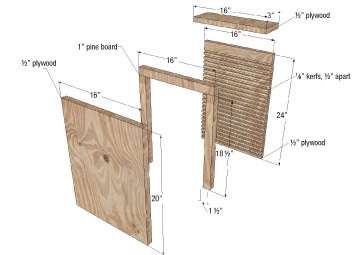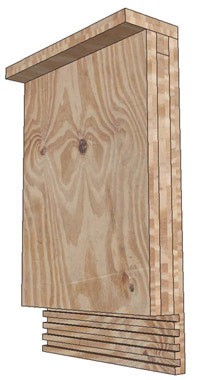White nose syndrome, a fungus that attacks bats while they’re hibernating, has been devastating to bats in the Northeast. (Editor’s Note: See our story “Bats on the Brink,” Spring 2010). As it’s human nature to want to do something to help, you might put a bat house on your list of winter woodworking projects. The carpentry is easy, making it a great project for those with little more than basic hammering skills.
Bats need dry, warm quarters of a certain size during the summer. During the day, they prefer to wedge into small crevices of ¾ to 1 inch, and they like it hot – somewhere between 80° and 100°F. That’s why your roasting attic is so appealing to them.
You will need several pieces of wood, including three pieces of ½-inch exterior grade plywood: one 20-by-16 inches (for the front), one 24-by-16 inches (for the back), and one 16-by- 3 inches (the roof). You’ll also need three pieces of one-inch thick (or ¾-inch finished) pine lumber to use as furring strips: two pieces 18½-by-1½-inches for the sides and one 16-by-1½-inches piece for the top. The larger piece of plywood is what the bats will cling to as they roost, so you’ll need to provide some texture for them to grab. Use a rasp or skill saw to add kerfs to one side of the plywood. You could, instead, fasten a 13-by-24-inch piece of insect netting onto the plywood for traction, but hold off until completing the next step if you plan to do that.
Stain the textured side with a dark exterior stain, then staple on the netting, if you are using it. Attach the furring strips to the rough side of the plywood with 1-inch exterior grade screws and exterior painter’s caulk. Keeping in mind that the bottom four inches is where the bats will land and enter the house, attach the front to the furring strips in the same way. Apply a bead of caulk to the top and screw on the roof, keeping one edge flush with the back.
Next, put a small piece of asphalt shingle or metal roofing on top – this will greatly extend the life of your bat house. In the Northeast, where summers are cooler than in other parts of the country, three coats of exterior grade black paint will help keep the house warm enough for the bats.
Carefully consider where you place your bat house. Full sun is a must, so don’t put it in a tree or under the eaves of a building. Bats don’t like lights, and they don’t like noise from air conditioners and air vents. They need a good water source close to their box; ponds are great, but a kiddie pool will work. Make sure reflective objects aren’t lighting up their box from below, and monitor for hornet infestations; hornets will cause bats to leave the house immediately.
Finally, be ready to welcome your good neighbors back in the spring with a clean and sturdy home.




Discussion *